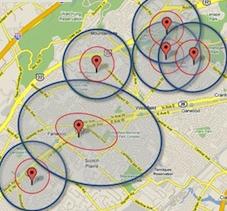 Geo-fencing technology has entered the online audio discussion and potentially affects legal and business issues. Most recently, according to an Inside Radio report, the ability to identify where users are listening to web-delivered audio is unlocking some previously-blocked sports.
Geo-fencing technology has entered the online audio discussion and potentially affects legal and business issues. Most recently, according to an Inside Radio report, the ability to identify where users are listening to web-delivered audio is unlocking some previously-blocked sports.
Recently we learned of a Viriginia radio group seeking a court order allowing its stations to escape paying performance royalties for its Internet streams, by limiting the streams to the key 150-mile radius stipulated in the U.S. Copyright Act for royalty-free re-transmission. that case challenges legal precedent established before geo-fencing existed.
Unlocking sports streams is a business issue related to team markets. Anyone who has used (or attempted to use) streaming video or audio to catch a game knows about market blackouts. If you’re in a team’s market, you might be blocked from receiving a video or audio stream so that TV and radio broadcast rights are not cannibalized. Conversely, if you’re out-of-market, you might not find an in-market stations’ webcast — because rights to webcast out-of-market games is owned by leagues.
Geo-fencing solves the market-boundary issue, at least in theory. (Some technologists believe that geo-fencing is immature and not always accurate.) Tech theory is good enough for some major leagues, according to Inside Radio, which reports that the NFL and NBA are taking the lead in allowing radio stations to unlock geo-fenced streams. Doing so allows the local stations to reach in-market listeners who live a multi-device lifestyle, while preserving the league’s out-of-market digital properties.
Geo-fencing was adopted, in part, to better target Internet listeners with ads relevant to their locations. Recent legal and business developments indicate that it could become a key streaming technology and business tool.
